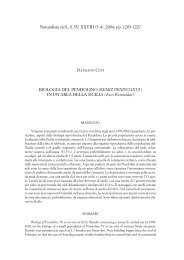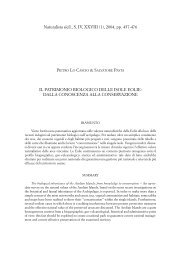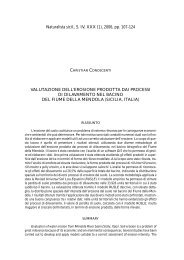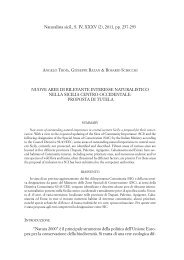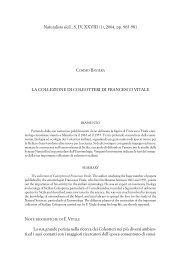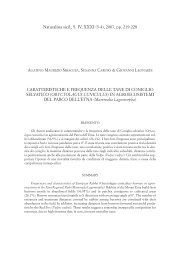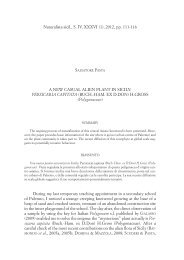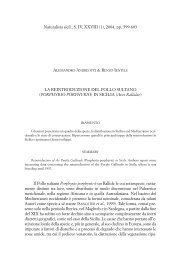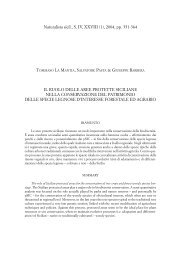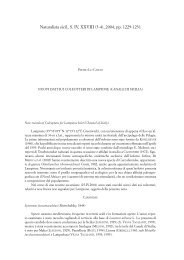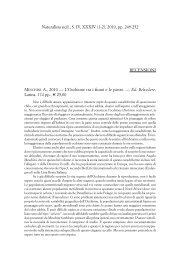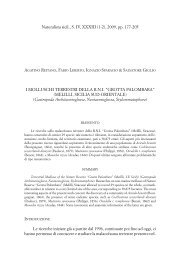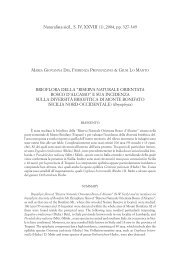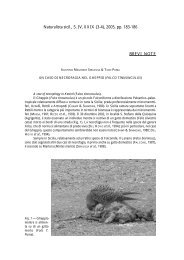2007,pp - Società Siciliana di Scienze Naturali
2007,pp - Società Siciliana di Scienze Naturali
2007,pp - Società Siciliana di Scienze Naturali
You also want an ePaper? Increase the reach of your titles
YUMPU automatically turns print PDFs into web optimized ePapers that Google loves.
266 M. SKUHRAVÁ, V. SKUHRAVY´ & B. MASSA<br />
MATERIAL AND METHODS<br />
We compiled all data on occurrence of gall midges in Sicily from the literature,<br />
revising all old fin<strong>di</strong>ngs of gall midge galls in articles of earlier<br />
authors, trying to identify the inducing insect previously unidentified. New<br />
material has been collected by B. Massa and his collaborators.<br />
Identification of galls is based on HOUARD (1908-1909, 1912), BUHR<br />
(1964-1965), of larvae on MÖHN (1955), of adults on SKUHRAVÁ (1997a).<br />
Nomenclature of gall midge species follows SKUHRAVÁ (1986, 1989) and<br />
GAGNÉ (2004), nomenclature of host plants TUTIN et al. (1964-1980) and<br />
PIGNATTI (1982). We analysed and evaluated all data that we gathered from<br />
the zoogeographical point of view, using the methods described by SKUHRAVÁ<br />
(1987, 1994a, 1994b, 1997b). Useful information on gall midges of economic<br />
importance may be found in seven-volumes work of BARNES (1946-1956), in<br />
NIJVELDT (1969) and in DARVAS et al. (2000).<br />
The collection of midge galls (voucher specimens) and microscope slides<br />
are preserved in the coll. M. Skuhravá; some gall specimens are preserved in<br />
the coll. B. Massa (Palermo University).<br />
RESULTS<br />
Together with species found by earlier authors, the current gall midge<br />
fauna of Sicily includes 89 species. They are associated with 77 host plant<br />
species belonging to 28 plant families. Asphondylia coronillae (Vallot, 1829)<br />
inducing galls on Coronilla emeroides and Dasineura acrophila (Winnertz,<br />
1853) on Fraxinus angustifolia are new records for Sicily. Houar<strong>di</strong>ella salicorniae<br />
Kieffer, 1912 inducing galls on Arthrocnemum cf. fruticosum, is a new<br />
record for Sicily, Italy and Europe. The correct host plant species of Aplonyx<br />
chenopo<strong>di</strong>i De Stefani, 1908, is Atriplex patula (L.) (Chenopo<strong>di</strong>aceae), not<br />
Chenopo<strong>di</strong>um album L. as it was given in the original description.<br />
Five gall midge species given in the list of SKUHRAVÁ (1995) as members<br />
of Sicilian fauna, viz. Contarinia quercicola (Rübsaamen, 1899), Dasineura<br />
ranunculi (Bremi, 1847), Drisina glutinosa Giard, 1893, Jaapiella bryoniae<br />
(Bouché, 1847) and Macrolabis hi<strong>pp</strong>ocrepi<strong>di</strong>s Kieffer, 1898, were excluded<br />
from our list because their presence in Sicily is not su<strong>pp</strong>orted neither by the<br />
voucher specimens nor by the evidence in the literature record.<br />
The majority of gall midges found in Sicily belongs to phytophagous<br />
species; Aphidoletes aphi<strong>di</strong>myza, Arthrocnodax coryligallarum, Feltiella<br />
acarisuga, Dicro<strong>di</strong>plosis pseudococci and Lesto<strong>di</strong>plosis aoni<strong>di</strong>ellae are preda-



